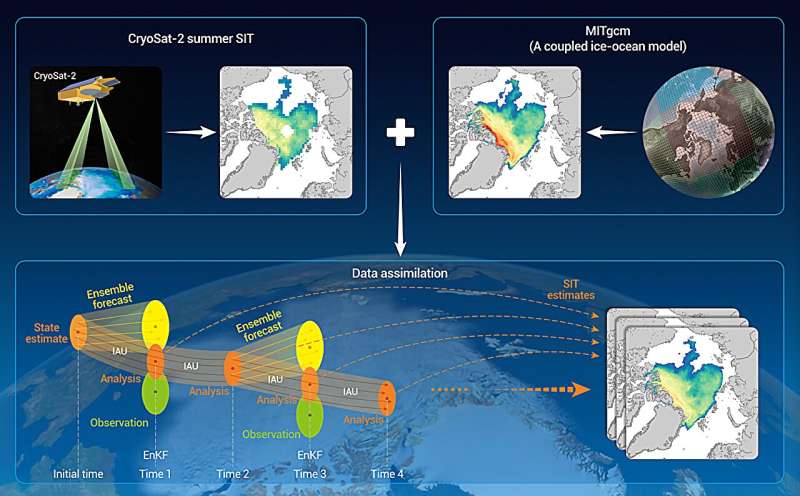This article has been reviewed according to Science X's editorial process and policies. Editors have highlighted the following attributes while ensuring the content's credibility:
fact-checked
proofread
The first assimilation of CryoSat-2 summer observations provides accurate estimates of Arctic sea ice thickness

Scientists have improved a data assimilation system for better estimating Arctic summer sea ice thickness (SIT) by assimilating satellite-based summer SIT and ice concentration data with an incremental analysis update (IAU) approach. Their study shows promising results for the improved estimations of Arctic SIT by assimilating the latest breakthrough of satellite-retrieved SIT for summer in the Arctic.
Their work was published in the journal Ocean-Land-Atmosphere Research.
The rapidly shrinking Arctic sea ice has significant impacts on the Earth system. The ongoing decline of sea ice has made commercial trans-Arctic travel more feasible in the summer. However, fast-changing sea ice conditions also pose challenges to maritime activities. Therefore, reliable estimation of Arctic sea ice, in particular SIT, using a combination of available observations and numerical modeling is urgently needed for the safety and route planning of maritime navigators.
"To date, there are no studies focusing on the assimilation of satellite-based SIT observations during summer. In this study, we assimilate the latest biweekly summer SIT and daily sea ice concentration data from satellite observations into a coupled ice-ocean model to improve the model estimates," said Dr. Chao Min at Sun Yat-sen University, and Southern Marine Science and Engineering Guangdong Laboratory (Zhuhai), China; and the Alfred Wegener Institute, Helmholtz Centre for Polar and Marine Research, Germany.
Prior to this study, satellite-derived summer SIT had not been assimilated into numerical models since SIT observations were limited in summer. Recent progresses on SIT observations based on CryoSat-2, a satellite dedicated to the study of ice, have provided scientists with reliable year-round sea ice data. With CryoSat-2 summer SIT, the team delved into the proper approach to assimilate CryoSat-2 data. Their study marks the first successful instance in which satellite-based summer SIT data has been assimilated into a coupled ice-ocean model.
Directly assimilating the rather infrequent CryoSat-2 observations would introduce discontinuities in the development of sea ice volume and thickness estimates. The team overcame this challenge by implementing an incremental analysis update (IAU) approach in their data assimilation system. The IAU method provides a gradual development of the sea ice fields over time while allowing the assimilation of infrequent summer SIT data, which are only available on the biweekly basis, in conjunction with daily sea ice concentration data.
The team's efforts have led to improved estimates of Arctic SIT, which exhibit stronger correlations with independent SIT observations when compared to a sea ice reanalysis (CMST) that does not incorporate CryoSat-2 summer observations. By combining CryoSat-2 summer observations and model dynamics, the team obtained significant improvements in sea ice estimates.
They noted significant improvements in the SIT field in the areas where the sea ice is roughest and experiences strong deformation, such as around the Fram Strait and the northern coast of the Canadian Arctic Archipelago and Greenland.
"Our findings demonstrate the benefits of assimilating CryoSat-2 summer SIT for estimating Arctic sea ice and hence improving the initial states for sea ice forecasts, which is highly relevant for marine navigation," said Dr. Lars Nerger at the Alfred Wegener Institute, Helmholtz Centre for Polar and Marine Research, Germany.
With this study, the team shows that a sea ice reanalysis that assimilates the year-round satellite ice thickness and concentration can be developed.
"A continuous long-term ice thickness record with a finer temporal-spatial resolution that assimilates both the year-round sea ice concentration and thickness will be reconstructed in the future. In addition, with the improved sea ice initial states, our data assimilation system has the potential to improve sea ice forecasts, particularly in summer," said Prof. Qinghua Yang, a professor at the School of Atmospheric Sciences, Sun Yat-sen University, and Southern Marine Science and Engineering Guangdong Laboratory (Zhuhai), China.
More information: Chao Min et al, Improving Arctic sea-ice thickness estimates with the assimilation of CryoSat-2 summer observations, Ocean-Land-Atmosphere Research (2023). DOI: 10.34133/olar.0025
Provided by Ocean-Land-Atmosphere Research (OLAR)




















